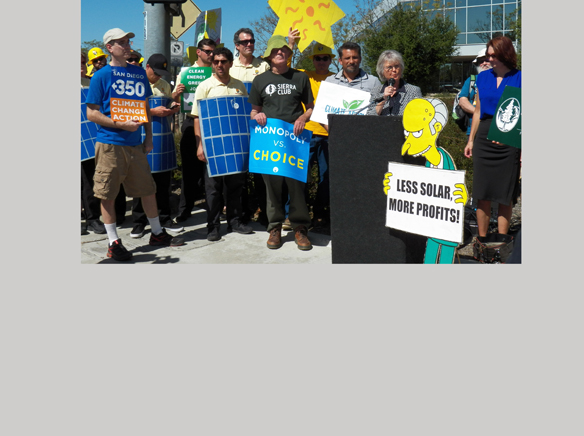The afternoon was sunny, and the solar power advocates were vocal on Wednesday, March 16, at the sidewalk protest rally outside San Diego Gas & Electric’s corporate headquarters in Clairemont. The protesters gathered to demonstrate opposition to SDG&E executives’ plans to lobby the California Public Utilities Commission for overturn of the CPUC’s decision that extends equal pricing treatment of customer-generated power from installation of rooftop solar panels with utility company-provided power.
The afternoon was sunny, and the solar power advocates were vocal on Wednesday, March 16, at the sidewalk protest rally outside San Diego Gas & Electric’s corporate headquarters in Clairemont. The protesters gathered to demonstrate opposition to SDG&E executives’ plans to lobby the California Public Utilities Commission for overturn of the CPUC’s decision that extends equal pricing treatment of customer-generated power from installation of rooftop solar panels with utility company-provided power.
The rally brought environmentalists and those advocating government interventions to mitigate climate change together with representatives of energy-cost ratepayers and solar energy businesses. There to represent residents of sunshine-abundant East County was Supervisor Dianne Jacob.
Organizers kicked off the event by explaining its purpose, to ensure that “making solar less affordable is not an option.” The activists reiterated their belief in a “100 percent clean energy future” that maintains solar power as a choice readily and equally available to local residents.
Jacob told the protesters, “We are here to deliver a loud message,” indicating one intended audience consisted of the SDG&E executives and employees in the nearby office building. “We are here to support competition in energy and to free up energy once and for all,” she said.
She cited the “8,000 jobs” in local solar businesses that would be cut, if SDG&E’s challenge for “modifications” of net metering is granted. Jacob said she was appearing at the rally to represent the “best interest of ratepayers,” and she listed recent questionable actions that SDG&E has taken, from the “unnecessary” Sunrise Power Line, to charging customers for closure of the San Onofre nuclear power station and costs associated with the East County wildfires.
“We are calling on the state regulators to stand firm,” Jacob continued. “The battle lines have been drawn. This is about who controls the energy future. We will continue to fight for the people.” Jacob predicted that the conflict over support for solar power could even spark a political campaign urging California legislators to “lift the cap on net metering once and for all.”
The relevant industry buzzword phrase is “net energy metering,” often abbreviated as “net metering.” The idea refers to customers with solar panels on their homes being enabled to transfer excess power beyond their household needs onto the energy grid and, in turn, being credited financially for that power supplied to other energy users, at the same rate as charged by the utility firm.
In late January, by a narrow 3-2 vote, the CPUC approved a legally required update in “net metering 2.0,” affirming the continuation of full retail energy credit to customers for the power their solar panels send to the power grid. (Assembly Bill 327, which set out financial incentives to encourage rooftop solar panel installation, further required consideration of revisions to those incentives, to be implemented in 2017.)
Should the CPUC vote stand, ratepayers with solar units will continue to have their utility meters “spin backwards” at the same use rate as meters are being charged when they need to take power from the grid at that time. Also under this CPUC decision, though, cost offsets will be added to solar power provider bills, as an accommodation to the regulated utilities. Customers with rooftop solar will pay an upfront installation fee and a monthly interconnection fee for power lines and maintenance of the grid.
Earlier this month, SDG&E, Pacific Gas and Electric (PG&E) and Southern California Edison filed a rehearing application, seeking to vacate the January CPUC decision that favors equal pricing treatment of customer solar energy and utility-provided power. That legal challenge was impetus for the rally.
For its organizational part, SDG&E responded after the rally with a press release, arguing that the fixed costs the company incurs translate into “unfairness” in higher energy bills shunted off onto low-income and disadvantaged communities to make up for the reduction of bills to those enjoying solar power benefits. Of SDG&E’s 3.5 million customers, over 82,000 have installed solar panels.
Also addressing the ralliers was Alejandro Montes, a student member of the Sierra Club, who spoke on behalf of the “next generation” and their desire for “a 100 percent clean energy future.” Montes decried the SDG&E stance as a “monopoly versus choice.”
Tara Kelly, who chairs the San Diego Chapter of the California Solar Energy Industries Association, closed out the half-hour protest, “We are blessed with sunshine most of the year here in San Diego.”
She described the choice as being between money for executive salaries and lobbyists intent on “stifling competition,” as “the solar revolution is upon us.” She urged listeners, “We must move forward united. This is the most important fight we have, the fight for our future.”














